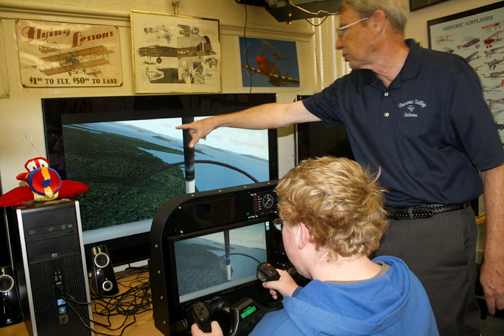
Lt. Col. Worley gives instructions to CVHS sophomore James Duquette during a demonstration of the JROTC flight simulator.
By Mary O’KEEFE
Imagine flying a plane over a green field and seeing the landing strip. You maneuver, adjusting the speed and keeping your eye on the instrument panel. The plane softly touches down and you breathe a sigh of relief. Now imagine this is all part of your classroom curriculum.
Crescenta Valley High School JROTC has acquired flight simulators that they have installed in their classroom. The simulators include an instrument panel, pedals that control the rudders and a monitor that acts as a windshield allowing the pilot to view his travels.
The program had one simulator up and running last year at Back to School Night, but this year there are two simulators and a third almost ready to be used.
“We start out talking about lift, thrust, drag and weight,” said Lt. Col. David Worley, the mentor/teacher for JROTC.
Before students get their hands on the new high tech simulator, they first learn about aerodynamics the old fashion way …
“We make paper airplanes,” Worley said.
By using paper airplanes, Worley added, the students learn lift by changing the wings of the plane.
With the one simulator the class had last year students were able to practice, but this year, the programs are more extensive and more realistic.
“Now we will have a refresher [course] and go over everything,” Worley said. “Before I can teach them flight they have to remember what they are doing.”
Each station costs about $1,500 to $2,000. Worley was able to hold fundraisers and collect donations from the community including a veterans’ group that donated $1,200. But $2,000 still needs to be raised to complete all three stations.
Each student will be able to learn using the simulator and at the end of the program they will be able to fly a single and twin-engine airplane and even an airliner. When the third station is completed, they will be able to fly helicopters. This will help them if they want to take courses at a flight school or help in determining a career in a variety of aerospace fields.
“We have two other [programs] that will teach them [how to fly] the Wright Brothers’ plane,” Worley said. “This is part of our aerospace curriculum and falls in line with the curriculum of STEM (science, technology, engineering and mathematics).”
During a recent visit at the JROTC classroom, sophomore James Duquette demonstrated the simulator for CVW. He monitored the plane as it flew over a field and toward an airstrip. Worley quietly gave some commands to help with the flight and the landing.
“I like the [program],” Duquette said.
When asked if flying was something he wanted to learn he said, “Yes, very much so.”
